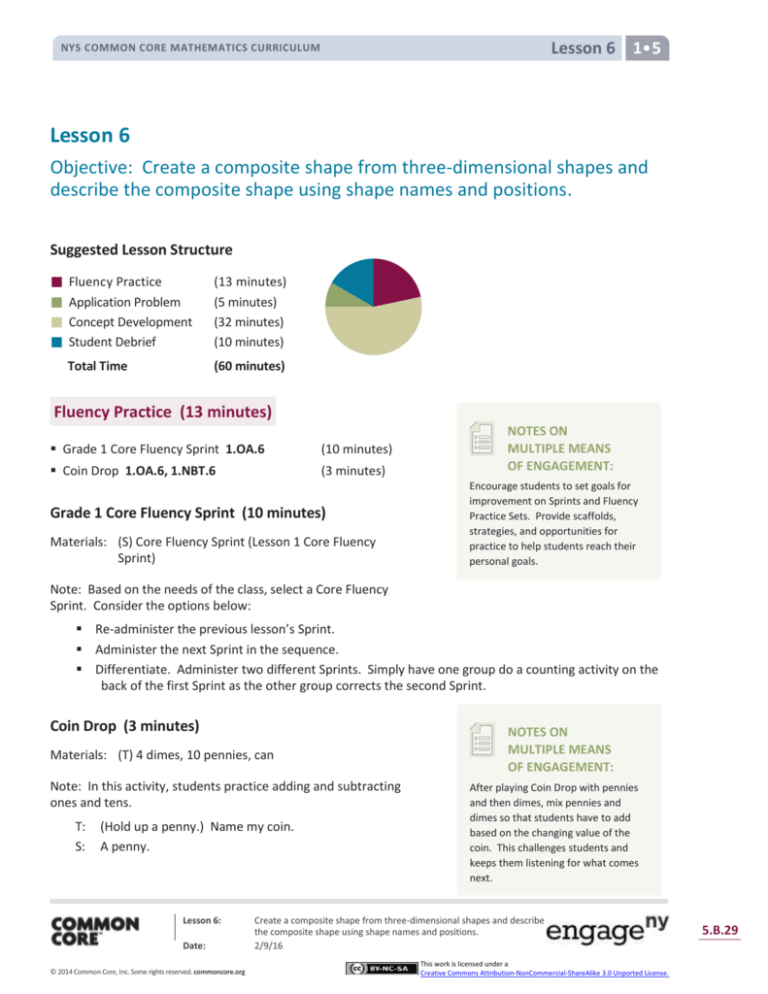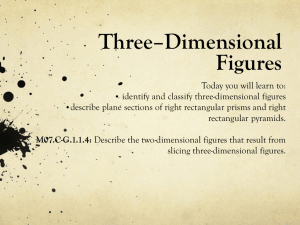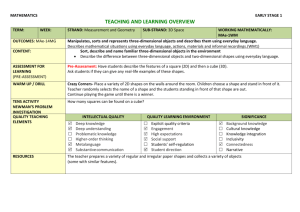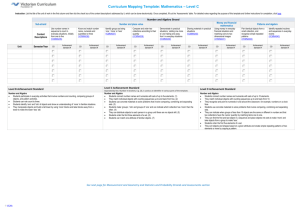
Lesson 6 1
NYS COMMON CORE MATHEMATICS CURRICULUM
Lesson 6
Objective: Create a composite shape from three-dimensional shapes and
describe the composite shape using shape names and positions.
Suggested Lesson Structure
Fluency Practice
Application Problem
Concept Development
Student Debrief
Total Time
(13 minutes)
(5 minutes)
(32 minutes)
(10 minutes)
(60 minutes)
Fluency Practice (13 minutes)
Grade 1 Core Fluency Sprint 1.OA.6
(10 minutes)
Coin Drop 1.OA.6, 1.NBT.6
(3 minutes)
Grade 1 Core Fluency Sprint (10 minutes)
Materials: (S) Core Fluency Sprint (Lesson 1 Core Fluency
Sprint)
NOTES ON
MULTIPLE MEANS
OF ENGAGEMENT:
Encourage students to set goals for
improvement on Sprints and Fluency
Practice Sets. Provide scaffolds,
strategies, and opportunities for
practice to help students reach their
personal goals.
Note: Based on the needs of the class, select a Core Fluency
Sprint. Consider the options below:
Re-administer the previous lesson’s Sprint.
Administer the next Sprint in the sequence.
Differentiate. Administer two different Sprints. Simply have one group do a counting activity on the
back of the first Sprint as the other group corrects the second Sprint.
Coin Drop (3 minutes)
Materials: (T) 4 dimes, 10 pennies, can
Note: In this activity, students practice adding and subtracting
ones and tens.
T:
S:
(Hold up a penny.) Name my coin.
A penny.
Lesson 6:
Date:
© 2014 Common Core, Inc. Some rights reserved. commoncore.org
NOTES ON
MULTIPLE MEANS
OF ENGAGEMENT:
After playing Coin Drop with pennies
and then dimes, mix pennies and
dimes so that students have to add
based on the changing value of the
coin. This challenges students and
keeps them listening for what comes
next.
Create a composite shape from three-dimensional shapes and describe
the composite shape using shape names and positions.
2/9/16
This work is licensed under a
Creative Commons Attribution-NonCommercial-ShareAlike 3.0 Unported License.
5.B.29
Lesson 6 1
NYS COMMON CORE MATHEMATICS CURRICULUM
T:
S:
T:
How much is it worth?
1 cent.
Listen carefully as I drop pennies in my can. Count along in your minds.
Drop in some pennies, and ask how much money is in the can. Take out some pennies, and show the class.
Ask how much money is still in the can. Continue adding and subtracting pennies for a minute or so. Then,
repeat the activity with dimes.
Application Problem (5 minutes)
Emi lined up 4 yellow cubes in a row. Fran lined up 7 blue cubes in a row. Who has fewer cubes? How many
fewer cubes does she have?
Note: Today’s Application Problem continues to provide
the opportunity for students to work with compare with
difference unknown problem types. For the past few days,
students have looked at questions that asked how many
more. Today’s question incorporates the challenging
vocabulary word fewer. Consider giving examples of the
word fewer prior to having students solve the problem.
Concept Development (32 minutes)
Materials: (T) Three-dimensional solids including cubes, cones, rectangular prisms, spheres, and cylinders,
1 large privacy folder (S) Sets of three-dimensional shapes, large privacy folder (1 per pair)
Note: This lesson works best with ample materials for each set of students. If a set of three-dimensional
solids is not readily available, use a collection of reused or recycled materials such as those listed in
Lesson 3.
On a table or desk, behind a privacy folder, gather the teacher’s
set of three-dimensional shapes so that students cannot see the
shapes as the teacher picks them up to build. Distribute the
materials to the students, seated at their desks or tables. Place
one additional sample of each shape on the floor or table in
front of the class for students who need visual reminders of
each shape.
T:
T:
I am going to build a three-dimensional structure but
hide it behind this folder. Listen to my description, and
try to build the same shape at your desk.
(Slowly describe the structure, providing time for
students to build as you explain each shape’s
placement.)
Lesson 6:
Date:
© 2014 Common Core, Inc. Some rights reserved. commoncore.org
NOTES ON
MULTIPLE MEANS
OF ENGAGEMENT:
While describing the composite
structure students are to build,
consider giving visual cues for certain
words. Otherwise, some students may
not be able to keep up with the
directions. Some will benefit from
directional cues or seeing the shape
they are supposed to place on their
desks.
Create a composite shape from three-dimensional shapes and describe
the composite shape using shape names and positions.
2/9/16
This work is licensed under a
Creative Commons Attribution-NonCommercial-ShareAlike 3.0 Unported License.
5.B.30
Lesson 6 1
NYS COMMON CORE MATHEMATICS CURRICULUM
T:
T:
S:
T:
S:
I am putting…
A cube on the table.
A cone on top of the cube so that the circular face is touching the top of the
cube.
Do you think your structure looks like my structure?
Share what you built with your partner.
(Discuss choices.)
(Remove the privacy folder to reveal the structure.)
Were you correct?
Yes! (Allow students a moment to adjust their
structure if they were not correct.)
Repeat the process, building a structure with three components, such
as the following:
T:
I am putting…
A rectangular prism with the longest face touching
the table.
A cube on top of the prism, directly in the middle.
Two cones on top of the prism, one on each end.
Repeat the process a third time, as described below:
T:
T:
T:
T:
S:
T:
(Slowly describe the structure, providing time for students to build while explaining each shape’s
placement.)
I am putting…
A rectangular prism with the longest face
touching the table.
A cylinder on top of the prism all the way to the
right, with the circular face touching the prism.
A cylinder on top of the prism all the way to the
left, with the circular face touching the prism.
A rectangular prism on top of these cylinders so
that it touches both cylinders.
A cone right in the center of this rectangular
prism, with the circular face touching the prism.
Let me repeat my description. As I do, look at your
structure and decide if you have everything where
you want it. (Repeat the description as students
check the structures they have created.)
Who is convinced they have the same structure that I have? Explain why you think you are correct.
(Use reasoning, along with the description that was provided.)
(Remove the privacy folder to reveal the structure.) Were you correct?
Lesson 6:
Date:
© 2014 Common Core, Inc. Some rights reserved. commoncore.org
Create a composite shape from three-dimensional shapes and describe
the composite shape using shape names and positions.
2/9/16
This work is licensed under a
Creative Commons Attribution-NonCommercial-ShareAlike 3.0 Unported License.
5.B.31
Lesson 6 1
NYS COMMON CORE MATHEMATICS CURRICULUM
S:
T:
S:
T:
S:
T:
Yes! (Allow students a moment to adjust their structures if they were not correct.)
Do you like my new composite shape?
Yes!
Do you think you could make and describe your own interesting composite shapes?
Yes!
With your partner, you are going to get to play the Build My Composite Shape Game that we just
played together.
Partner A will make a structure behind his hiding folder. Partner B should turn his back so
that he cannot peek. Partner A will tell Partner B when to turn around.
As Partner A describes the structure, Partner B tries to make it with her three-dimensional
shapes. When she thinks she has the right structure, Partner A removes the folder, and they
compare structures.
The partners switch roles. Continue to take turns until time is up.
As students play, circulate and ensure that students are using precise language to describe the position and
location of their three-dimensional shapes. When partners are building different structures, ask Partner A to
explain the location and position of the shapes again, and support clear communication between the
students.
Problem Set (10 minutes)
Students should do their personal best to complete the
Problem Set within the allotted 10 minutes. For some
classes, it may be appropriate to modify the assignment
by specifying which problems they work on first.
Student Debrief (10 minutes)
Lesson Objective: Create a composite shape from threedimensional shapes and describe the composite shape
using shape names and positions.
The Student Debrief is intended to invite reflection and
active processing of the total lesson experience.
Invite students to review their solutions for the Problem
Set. They should check work by comparing answers with a
partner before going over answers as a class. Look for
misconceptions or misunderstandings that can be
addressed in the Debrief. Guide students in a
conversation to debrief the Problem Set and process the
lesson.
Lesson 6:
Date:
© 2014 Common Core, Inc. Some rights reserved. commoncore.org
Create a composite shape from three-dimensional shapes and describe
the composite shape using shape names and positions.
2/9/16
This work is licensed under a
Creative Commons Attribution-NonCommercial-ShareAlike 3.0 Unported License.
5.B.32
Lesson 6 1
NYS COMMON CORE MATHEMATICS CURRICULUM
Any combination of the questions below may be used to lead the discussion.
Which three-dimensional shapes did you choose to use and why? Why did you choose to leave
some shapes out?
Were more spheres or cubes used in the structures? Why might that be?
Find two three-dimensional structures that used the same pieces to make different larger
shapes. Explain the similarities and differences.
Look at today’s Sprint. Explain how the answer to the first number sentence helped you easily
solve the next number sentence.
Exit Ticket (3 minutes)
After the Student Debrief, instruct students to complete the Exit Ticket. A review of their work will help with
assessing students’ understanding of the concepts that were presented in today’s lesson and planning more
effectively for future lessons. The questions may be read aloud to the students.
Lesson 6:
Date:
© 2014 Common Core, Inc. Some rights reserved. commoncore.org
Create a composite shape from three-dimensional shapes and describe
the composite shape using shape names and positions.
2/9/16
This work is licensed under a
Creative Commons Attribution-NonCommercial-ShareAlike 3.0 Unported License.
5.B.33
NYS COMMON CORE MATHEMATICS CURRICULUM
Name
Lesson 6 Problem Set 1
Date
1. Work with your partner and another pair to build a structure with your
3-dimensional shapes. You can use as many of the pieces as you choose.
2. Complete the chart to record the number of each shape you used to make your
structure.
Cubes
Spheres
Rectangular Prisms
Cylinders
Cones
3. Which shape did you use on the bottom of your structure? Why?
4. Is there a shape you chose not to use? Why or why not?
Lesson 6:
Date:
© 2014 Common Core, Inc. Some rights reserved. commoncore.org
Create a composite shape from three-dimensional shapes and describe
the composite shape using shape names and positions.
2/9/16
This work is licensed under a
Creative Commons Attribution-NonCommercial-ShareAlike 3.0 Unported License.
5.B.34
NYS COMMON CORE MATHEMATICS CURRICULUM
Name
Lesson 6 Exit Ticket 1
Date
Maria made a structure using her 3-dimensional shapes. Use your shapes to try to
make the same structure as Maria as your teacher reads the description of Maria’s
structure.
Maria’s structure has:
1 rectangular prism with the shortest face touching the table.
1 cube on top and to the right of the rectangular prism.
1 cylinder on top of the cube with the circular face touching the cube.
Lesson 6:
Date:
© 2014 Common Core, Inc. Some rights reserved. commoncore.org
Create a composite shape from three-dimensional shapes and describe
the composite shape using shape names and positions.
2/9/16
This work is licensed under a
Creative Commons Attribution-NonCommercial-ShareAlike 3.0 Unported License.
5.B.35
Lesson 6 Homework 1
NYS COMMON CORE MATHEMATICS CURRICULUM
Name
Date
1. Use some 3-dimensional shapes to make another structure. The chart below gives
you some ideas of objects you could find at home. You can use objects from the
chart or other objects you may have at home.
Cube
Rectangular
prism
Cylinder
Sphere
Cone
Block
Food box:
Food can:
Tennis ball
Ice cream cone
Cereal,
macaroni and
cheese,
spaghetti, cake
mix, juice box
Soup,
vegetables,
tuna fish,
peanut butter
Tissue box
Toilet paper or
paper towel roll
Rubber band
ball
Party hat
Hardcover book Glue stick
Basketball
Funnel
DVD or video
game box
Soccer ball
Dice
Ask someone at home to take a picture of your structure. If you are unable to take
a picture, try to sketch your structure or write the directions on how to build your
structure on the back of the paper.
Lesson 6:
Date:
© 2014 Common Core, Inc. Some rights reserved. commoncore.org
Create a composite shape from three-dimensional shapes and describe
the composite shape using shape names and positions.
2/9/16
This work is licensed under a
Creative Commons Attribution-NonCommercial-ShareAlike 3.0 Unported License.
5.B.36








